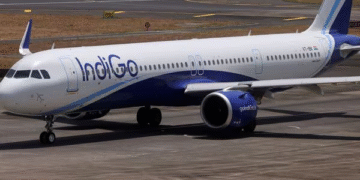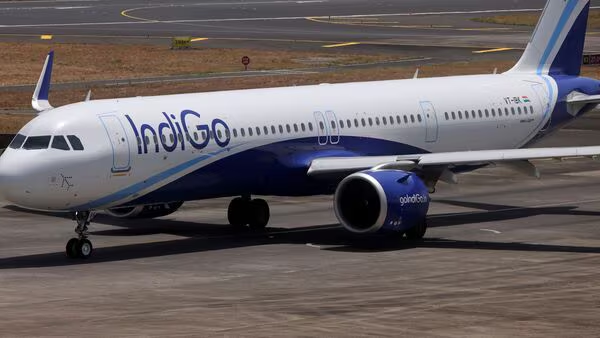A power bank caught fire on an IndiGo flight to Dimapur while taxiing at Delhi airport, triggering panic among passengers. Here’s what happened and how the situation was handled
fire onboard IndiGo flight 6E 2107 while taxiing at Indira Gandhi International Airport (IGIA), New Delhi, en route to Dimapur in Nagaland. While no injuries were reported, the episode has triggered renewed attention to the risks posed by lithium‑ion batteries in aircraft cabins — and raised questions about passenger awareness, airline protocols and regulatory oversight.
What Happened
According to airline and media reports:

- Flight 6E 2107, an Airbus A320 neo, was preparing for departure from Delhi to Dimapur when the incident occurred.
- While the aircraft was taxiing (i.e., moving from its parking bay toward the runway), cabin crew noticed smoke emanating from a seat‑back pocket containing a passenger’s personal electronic device — later identified as a power bank.
- The crew acted immediately: the aircraft returned to the bay for inspection; the fire was extinguished using onboard fire‑fighting equipment, and airport emergency teams were alerted though not required to step in.
- IndiGo’s official statement emphasised that the crew followed standard operating procedure and the incident was “controlled within seconds”.
- All passengers and crew were reported safe; no injuries, no damage to the aircraft declared; after checks, the flight was cleared to proceed.
Why It Matters
Aviation Safety & Lithium‑ion Batteries
Lithium‑ion batteries, such as those found in power banks, smartphones and other portable electronics, are inherently volatile under certain conditions: over‑heating, short‑circuiting, physical damage or improper storage can lead to thermal runaway — a rapid onset of fire or explosion. Onboard aircraft, any fire is critical due to confined space, presence of fuel vapour, sensitive electronics and limited time for evacuation.
In this case, the fire occurred while the aircraft was still on the ground, which likely averted a far worse scenario. As reported:
“Fire scare on IndiGo flight … passenger’s power bank erupts in flames at Delhi airport; crew extinguishes blaze.”
Passenger Awareness and Aircraft Rules
While airlines publish rules about carrying power banks — e.g., permitted only in cabin (not checked‑in luggage), limited capacity (often < 100 Wh) — anecdotal evidence and user forums show many passengers are unaware of the restrictions or hazards. For example:
“Yeah just keep it in the tray … From their website: ‘Power must be visible on the battery, more than 160 Wh is not allowed’.”
This incident underlines the need for stricter enforcement and better passenger education.
Operational Disruption & Brand Impact
Though IndiGo handled the incident efficiently, the flight had to return to bay and undergo checks before resuming. This kind of incident has implications for airline brand image, passenger confidence and operational cost (delays, inspections, possible compensation).
Airline & Regulatory Response

- IndiGo issued a statement: “The crew managed the situation quickly and diligently following the standard operating procedure, and the incident was controlled within seconds.”
- The airline thanked customers for their calm and cooperation and noted that refreshments were offered to mitigate inconvenience.
- Authorities at IGIA and relevant safety/regulatory bodies are expected to review the incident, determine root cause (e.g., whether the power bank was compliant, passenger handling of device, battery capacity, storage location) and recommend any further safety mitigation.
Key Takeaways & Lessons for Travellers
- Power banks must be carried in the cabin, not in checked‑in baggage. Many aviation authorities — including India’s Directorate General of Civil Aviation (DGCA) — forbid high‑capacity lithium batteries in hold luggage due to fire risk.
- Check the capacity of your power bank. If the Wh (watt‑hour) rating exceeds the permitted limit (e.g., 100 Wh domestically, 160 Wh for some international flights) you may be asked to surrender it.
- Store electronics safely during flights. Avoid placing power banks or devices loose in seat‑back pockets, overhead bins near heat sources, or under cushions.
- Follow crew instructions. In case of any smoke or heat, inform crew immediately rather than trying to handle it yourself. Fire incidents in aircraft can escalate rapidly.
- Be aware of airline-specific policies. Each airline/airport may have slightly different rules. For example, many Indian carriers require power banks to be carried in hand luggage and switched off during take‑off/landing.
What Happened Next for Flight 6E 2107
After the fire was extinguished:
- The aircraft returned to the parking bay for safety inspection and checks.
- Once cleared, the flight departed for Dimapur. According to Flightradar24 data, the actual take‑off occurred at 14:33 hrs and arrival at Dimapur at 16:45 hrs.
- IndiGo clarified that no damage was reported and operations resumed normally.
The Bigger Picture: Similar Incidents
Recent aviation safety reports emphasise that this is not an isolated event: earlier this week, a lithium battery in the overhead compartment of a Air China aircraft (Hangzhou→Seoul) reportedly caught fire.
These recurring episodes highlight the latent risk posed by portable electronics and the need for robust regulations globally.
Expert Viewpoint
While no expert quotes were publicly released specifically for this incident, aviation safety analysts stress that:
- The moment of taxiing is critical because engines are operating, electrical systems are active, and evacuation options are limited (doors may still be closed).
- Quick crew response and built‑in fire‑extinguishing capability are key factors in avoiding major escalation.
- The incident will likely trigger regulatory review of how personal electronic devices (PEDs) are stowed, monitored and managed in cabin areas — especially with the surge in high‑capacity power banks among travellers.
Passenger Perspective
For the passengers on board Flight 6E 2107:
- The crew’s swift action prevented panic from turning into chaos, according to reports.
- Though the delay may have caused some inconvenience, the terminal and airline appear to have taken proactive steps (refreshments, reassurances) to ease the experience.
- This incident may make travellers more cautious about how they carry and handle their electronic devices.
What Should Airlines & Airports Do?
- Strengthen pre‑boarding screening to identify large/flagged power banks or batteries.
- Reinforce crew training on battery‑related fire incidents, including drills and handling of seat‑back pocket fires.
- Publicly communicate clear policy on battery capacity, device placement and stowage during flight phases.
- Encourage passengers to declare high‑capacity power banks and use designated storage during taxi, take‑off, landing phases.
- Airport fire and emergency units should maintain readiness for cabin fires even before take‑off or after landing — taxiing and engine start phases are vulnerable moments.
In Summary
While the fire from a power bank aboard an IndiGo flight was minor and swiftly controlled, the incident underlines a persistent aviation risk — that of lithium‑ion battery fires in confined aircraft spaces. Thanks to crew professionalism and standard operating procedures, a potentially serious event was averted. For passengers, it is a timely reminder to understand and obey guidelines around carrying power banks and electronics during flights. For airlines and regulators, it reinforces the importance of vigilance and proactive risk management in cabin safety.
Also Read : How Will Mumbai Weather Be Like on Diwali Day? Check IMD Forecast















 Categories
Categories









